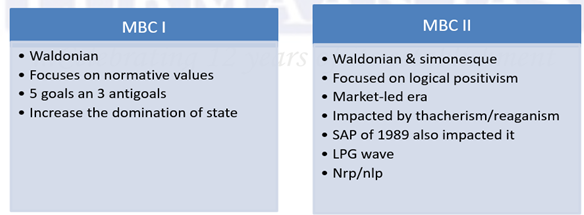Answer:
APPROACH AND STRUCTURE
1. Write an introduction on MBC II.
2. Compare the context of MBCII with MBC I.
3. Then write about NPM approach.
4. Then write influence of NPM on MBC II.
5. MBC II did not openly accepted NPM.
6. Conclude
INTRODUCTION: 20 years after the Minnowbrook -I Conference, the Minnowbrook -II was organized to mark the legacy however in a completely different backdrop of rise of Globalisation during 1980s.
BODY: The Minnowbrook-II was headed by George Fredrickson, held in 1988 and attended by 68 Scholars from diverse disciplines like political science, history, economics apart from Public Administration. Its subject matter was divided into 11 themes. Out of these, 5 were about historic perspectives and review of Minnowbrook -I while 6 themes were about present and future including Gender, Environment, Leadership and Diversity.
The Second Minnowbrook Conference was held after a gap of twenty years. The conference, held on September 4, 1988, was attended by sixty-eight scholars and practitioners of public administration and other disciplines such as history, economics, political science, psychology and so on. The conference was held against the backdrop of the changing role of state and government, more privatisation, contracting out, and increasing role for non-state actors in the governance process. Similarly, MBC II was also concerned about these aspects as the conference was being held in the backdrop of “ascendancy of neo liberalism, privatisation, contracting out, third party government, downsizing” etc which created serious confusion as to the focus and locus. The question asked was if the state itself is being marketised, can there be anything left as “public” and as there will be no public and thus no PA.
 Therefore, MBC II couldn’t ignore the tools and techniques, methods and ideas of NPM and tried to change the administration which are propagated based on managerial values. Since MBC-II was receptive to others’ contributions including the Simon-Waldo debate giving way to Simonesque and Wadonian perspective, MBC-II does incorporate the efficiency approach of NPM.
Therefore, MBC II couldn’t ignore the tools and techniques, methods and ideas of NPM and tried to change the administration which are propagated based on managerial values. Since MBC-II was receptive to others’ contributions including the Simon-Waldo debate giving way to Simonesque and Wadonian perspective, MBC-II does incorporate the efficiency approach of NPM.
However, even if it tacitly accepted the managerialism yet the theoretical premises and outlook of MBC II were different from managerialism which is more grounded on economics and management. Even if ‘privatization’ was accepted tacitly, there was a strong negative attitude towards business. Conversely, MBC-II was based on political theory and propagates the core ideas of political theory which are similar to 5 goals (social justice, change, relevance, equity, value) given in MBC-I.
So, MBC-II continues the legacy of minnowbrook. Even if it brought managerial aspect as means but at the same time, the goals, values and normative aspects remain ends. Therefore, we can consider that MBC-II platform as more as extension of MBC-I having continuity of NPA rather than propagating values of NPM.
CONCLUSION: Minnowbrook-II tried to balance the democratic past and emerging market based future by tacitly accepting LPG as the conference was more receptive and pragmatic in its nature. Due to a different setting, the MBC-II outcome was termed as “constrained hopefulness”. This dilemma was resolved ultimately in Minnowbrook-III which accepted methodological pluralism and embraced all three different approaches – the Traditional Administration, NPM and NPS in its theme.
Spread the Word




